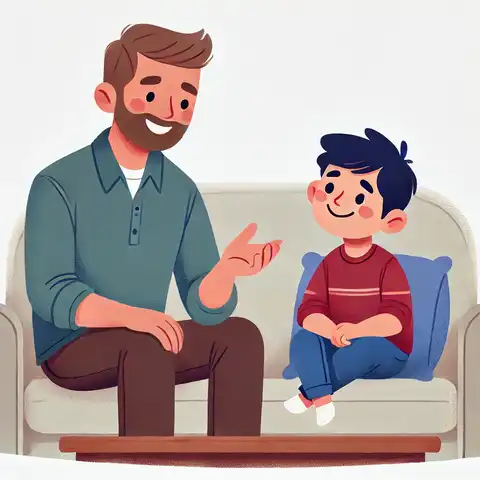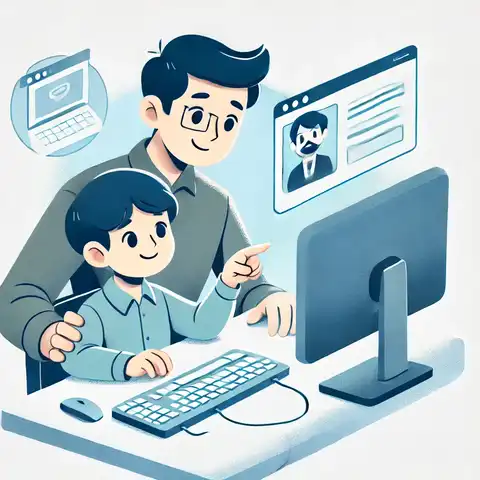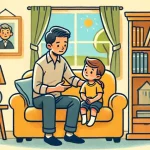Teaching kids about boundaries: Boundaries keep our kids’ space and feelings safe while communicating what is expected. They help kids learn to respect themselves and others. Kids also learn how to make friends, communicate well, and feel safe when they have proper information about the limits.
We will also explore ways to encourage children to feel safe setting their boundaries and when they should seek help.
What Are Boundaries?
It is basically rules that teach us what to do in various situations. They safeguard an individual’s bubble, emotions and prerequisites. Understanding boundaries is being able to say no, acknowledging when someone else says it and respecting personal space.
Physical boundaries: Personal space, hugging/hitting without permission, or not touching Emotional boundaries.
Different Types of Boundaries
Boundaries Different types of boundaries kids need to learn:
- Physical Boundaries: This includes personal space and touch.
- Emotional Boundaries: These save thoughts and feelings.
- Online Safety: This refers to the digital boundaries.
Why Kids Need Boundaries

Kids need boundaries as they assist kids, making them feel protected and respected. Kids begin to learn about boundaries—this is okay, that’s not okay. This is why kids need boundaries.
Helping Kids Feel Safe
Establishing obvious limits helps young children feel protected. Once they know these rules, they can be better prepared for what to expect, which makes them feel secure.
If, for instance, your child knows that touching them without permission is inappropriate, they will have an added barrier of protection—the benefit of knowing when something illegal has just occurred.
Teaching them Self Respect
Working towards creating boundaries with your kids can teach them to respect themselves. They come to understand that they are entitled to how they feel and their own space. They know that if they come across something out of the ordinary, it’s not taboo to say “no.” It lifts their self-esteem and lets them know that they are able to say “no.”
Learning to Respect Others
Boundaries are also how kids learn to be respectful of others. Children who know that each person has their own space and feelings understand how to be kind. This means they know not to poke and prod others without asking or spitting out mean things. It will enable kids to make friends and get along with others.
Reducing Arguments
Boundaries keep kids from fighting and arguing. The more they learn about how to share and play nice, the less likely they are to do something that might upset other kids. The dogs do get a bit protective of their dolly, but it’s all for peaches and playtime.
Making Good Choices
Kids can make good decisions by setting boundaries. Once children are aware of their boundaries, they can select the best for themselves. For example, if a child is tired of playing rough, he can say “no” and do something else.
Protecting Themselves
Boundaries help kids know how to keep themselves safe from unsafe things. They understand their right to say “no” whenever something seems off, wherever they are, including feet from home.
Building Healthy Friendships
Healthy Fucking Boundaries are GOLDEN with friends. Young people who understand that everyone is entitled to their own space and feelings can foster supportive, robust relationships. And the kids still come to realize that good friends listen and accept each other’s decisions.
Preparing for the Future
Kids who learn boundaries become adults who manage their lives. They are then prepared to enter into healthy relationships as adults, able to set and honor boundaries.
When to Begin Teaching Boundaries

But you can teach boundaries young! Even toddlers learn basic concepts such as personal space and sharing.
Hope to teach your kid when s/he is little, & what you mean by that.
If for small children, then simple words and clear examples. Teach them to ask before hugging, and you teach them not to touch other children. They can also learn to wait for their turn and not touch others without permission.
How Early in My Child’s Life Should I Begin Instilling Boundaries?
Boundaries can be taught as early on in a child’s life as you are willing to start. Toddlers can learn to share and give personal space. The younger they know, the more respectful they become of themselves and others.
Use easy words and clear examples for young children. Teach toddlers to only hug when they ask and keep their hands well. Preschoolers should also learn that they have to let others take their turn and not touch someone else if they are uncomfortable with it.
How To Teach Child To Respect Others Boundaries

How do you teach your child basic respect for other people`s boundaries?
- Break it down simply: freedom to say no, with examples of simple language. Such as, “Everyone has a bubble. Until they tell us that we can get too close.”
- Ask First: Motivate your child to ask before commissioning with something. To be honest, you can just say: “Ask your friend if they need a hug before hugging them.”
- Pretend Play: Create circumstances where your child might need to respect boundaries. You can ask a question, for example, if they let you play with toy X and speak to it, pretending like your child says, “No,” what do YOU have to do?
- Empathy is Key: Encourage your child to empathize with how the other person might feel if their boundaries are not respected. Ask them, “How would you like it if so, and so just took your toy away?
While we may not want to reward normal human behavior, reinforcing the positive is an excellent way of helping our kids develop a sense of external responsibility and empathy for others. Tell them how great of a job they did.
How Can I Demonstrate Healthy Boundaries to My Child?
Here is how you can teach your child to set and honor boundaries
- It is okay to have Boundaries of your Own: Let kids see that it is right to keep their boundaries. If you need quiet time, then say, “I really do not want to talk right now, so I am going to sit here.
- Say What You Want: Be as plain in your words as possible, stating what you desire. You can say something like, “I’m not comfortable when someone is too close to me, and I need space.
- Model Respect for the Choices of Others (Teach respect). For instance, if a friend does not want to hug you…you can say, “That is okay. We will just wave goodbye instead.”
- Apologize When Appropriate: If you violate someone’s boundary, say sorry. Show your kid how to do it right. For instance, say, “I’m sorry I interrupted you. I will wait for you to finish speaking.
How Do I Support My Child to Feel Safe Setting Their Boundaries?

So, how do we make it easy for the brain to give us what we want?
Promote Open Communication: Inform your child that if something does not feel right, they can speak up. MUST TEACH THEM “I” STATEMENTS; I DO NOT LIKE IT WHEN YOU TELL ME WHAT TO DO.
- Saying no: You can role-play various scenarios where your child might have to say “no,” like when someone asks them if they want something or play the following game.
- How to help your child: Praise Their Boundaries — When your child is trying to set a healthy, loving boundary, praise the hell out of them.
- Create a Comfort Space — Always let your child know that they can always come to you for help or if someone crosses their boundaries.
- Teach by example: Model setting boundaries for them, and do not cross them yourself. Allow them to witness you saying no as well and respecting other people’s boundaries.
What If My Child’s Boundaries Are Crossed?
Here are some ways you can help your child if their boundaries have been crossed.
- Listen: Provide your child with a safe place to share what happened. Let them speak without interruption; simply listen and indicate that you agree with what they are saying. Or you could say, “Yikes, that must have been rough. Wow, that sounds pretty traumatic.”
- Reassurance: Make sure your child knows this is not their fault and that they did the right thing by telling you.
- Address the Issue—Discuss what happened and why it was a breach of boundaries. Teach your child strategies for the next time something like that happens.
- Next Steps: If warranted, you may have to speak with the other child’s parents, a teacher or a counselor so that this can be addressed appropriately.
- Seek professional help: If your child is having difficulty coping with the situation, or if it was a much more severe incident, consider reaching out to a therapist.
Teaching My Child Consent
Teaching your child about consent can be summed up by the following:
- Define Consent: Let your child know that consent involves asking before you touch someone or enter their space and accepting the answer—whether it is “yes” or “no.” Any version of this message works fine; for example, something like “Consent means checking with someone to see if they are okay with what we want to do.”
- Not practicing: As with any new challenge in life, you need to practice what asking for consent looks like –talk about different scenarios where they would have to ask and also not. As an example, enact a scene where you ask permission to hug your friend or borrow his toy. Talk about what happens if the answer is ‘no.
- Promoting Respect for What Others Want: Highlight that it is as essential to pay heed to other people and their choices as they want others to do for them. You might say, “If someone says no, we must respect that and do not force us on them.
- Make It Relevant: Anco, you use life situations to explain consent. For instance, if your child wishes to pat a dog, encourage them to ask the owner first.
- Model Consent: When you share a sandwich, allow your child to see you asking for and depending on consent. You could, for instance, ask your child, “Would you like a hug?
How do I know when my child is struggling to honor the boundaries?
- Types of Toddlers My Need Because you overweight can be this sign to the way Storm beck if she is one:
- Difficulty Saying “No”: If your child has difficulty with saying no when asked or always just goes along and agrees to what someone else wants, they may need to practice setting healthy boundaries. They must know that it is OK to say NO when they are not comfortable.
- Discomfort with Physical Touch: If your child is either apprehensive about being touched by people or unsure of how to react when someone tries, they might be in need of direction as to what kind and amount are okay.
- Guilt: If your child is feeling guilty or too afraid to say “no,” — they might need a pep talk.
- Ignoring Others’ Boundaries: Your child may need assistance in learning when someone else is giving signals of being uncomfortable (e.g., avoidant behavior such as turning away or stiffening posture) and they are unwanted to be touched.
- Argumentative with Friends: If your child has frequent fights or is unable to keep friends, this might indicate that they don’t know their place and are not able to respect boundaries.
How to Teach Your Child About Boundaries Using Books and Stories
Democratic Values in Literature: Choose those stories where characters obey or violate limits.
- Read Together: Spend time together with your child reading these books. Discussing what the characters learned after this reading could be a good follow-up question. For example, you might ask, “What was the character feeling when their own kind broke that code?”
- Use Real-Life Examples: When you finish the story, discuss real-life situations in which they can employ this lesson.
- Ask for Thoughts: Ask your child how they would handle different boundary-related scenarios.
If your child may have trouble remembering these new boundaries, try reinforcing the learning with some stories. You could say something like, “Like how today when you didn’t want to play that game one of the characters said ‘no’ and stayed behind instead. You can do that, too.”
Possible Instances To Seek Professional Help
- Continuing Boundary Struggles: If, after providing adequate support, your child continues to have difficulty with boundaries, speak with a therapist or social worker.
- Help Them Deal with Their Emotional Upset: If your child is emotionally traumatized, worried or sad about the way their boundaries are set in place, having a therapist working together can be highly advantageous.
- Extreme Boundary Issues: When a child has experienced real issues, such as bullying or abuse. Find professional help to restore the situation.
- Difficulty with Social Situations: If your child has difficulty making or keeping friends, or if they do not know how to behave around others, a professional could assist them in learning social skills and understanding personal boundaries.
- If You Have Safety Concerns: If you are genuinely worried about your child’s safety because of boundary problems, it is time to get help from an expert.
Boundaries, children, and parenting go together in any family of any size. It teaches them self-respect and respect for others. Make clear rules, show healthy boundaries and talk with your child to help them learn about natural consequences in a positive way.
However, always consider that teaching boundaries is an ongoing process. It takes patience, commitment and empathy.
By doing this, your child will learn to respect them too and grow up being able to maintain boundaries well. Forming healthy, strong relationships goes so much deeper than simply a good conversation.


